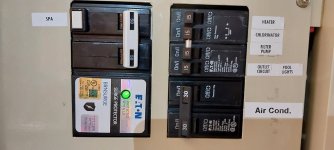- Aug 2, 2024
- 17
- Pool Size
- 12500
- Surface
- Vinyl
- Chlorine
- Salt Water Generator
- SWG Type
- Jandy Aquapure 1400
One of my two LED lights failed. Are you surprised?
I keep my pool at 40°F in winter. When installing LED lights, specifically Pentair Microbrite, I used the dry conduit o-ring, silicone, and teflon tape.
1) Is this enough to prevent water from entering the conduit and causing freeze damage?
1a) Will the light overheat without water in the conduit?
2) Should I pour some sort of non toxic antifreeze into the conduit in case water seeps into the conduit?
2a) Will this create a heat sink thus extending the life of the light?
It's evident that LED pool lights from all brands tend to fail before their rated lifespan. This leads to expensive replacement over the life of the pool. I can only assume this is due to overheating and possible unstable supply voltage/spikes, and general wear on the circuitry. Would a fiber optic system using a single high power light source be cheaper in the long run? Keep in mind that even if it still uses LED, the light would be above ground, with ample cooling and probably a cheaper replacement than a pool light. And if it uses metal halide or halogen, electricity is cheaper at night, and use can be occasional, so savings far outweigh the cost and inconvenience of periodic LED replacement.
So, I guess I'm looking for advice to either inconveniently replace my broken expensive pool light, and continue replacing both lights periodically, or install fiber optic and just deal with a single light source.
I keep my pool at 40°F in winter. When installing LED lights, specifically Pentair Microbrite, I used the dry conduit o-ring, silicone, and teflon tape.
1) Is this enough to prevent water from entering the conduit and causing freeze damage?
1a) Will the light overheat without water in the conduit?
2) Should I pour some sort of non toxic antifreeze into the conduit in case water seeps into the conduit?
2a) Will this create a heat sink thus extending the life of the light?
It's evident that LED pool lights from all brands tend to fail before their rated lifespan. This leads to expensive replacement over the life of the pool. I can only assume this is due to overheating and possible unstable supply voltage/spikes, and general wear on the circuitry. Would a fiber optic system using a single high power light source be cheaper in the long run? Keep in mind that even if it still uses LED, the light would be above ground, with ample cooling and probably a cheaper replacement than a pool light. And if it uses metal halide or halogen, electricity is cheaper at night, and use can be occasional, so savings far outweigh the cost and inconvenience of periodic LED replacement.
So, I guess I'm looking for advice to either inconveniently replace my broken expensive pool light, and continue replacing both lights periodically, or install fiber optic and just deal with a single light source.







